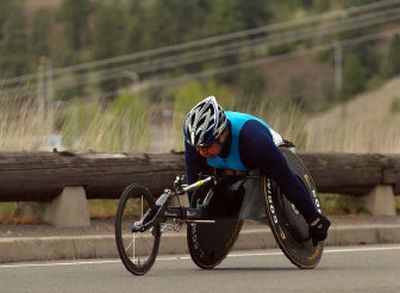Mendoza wins ninth straight men’s wheelchair title

Another year brought another Bloomsday men’s wheelchair title to Saul Mendoza, but the ninth straight one meant a little more.
It breaks Craig Blanchette’s record of consecutive race victories, which he set from 1987-94.
“It means a lot. This is one of my favorite races, which is why I put it in my calendar every year,” said Mendoza, a 39-year-old who resides in Wimberley, Texas.
He finished with a time of 27 minutes, 20 seconds. to win $2,000, 2:19 ahead of Ferris graduate Tyler Byers, now living in Reston, Va.
Mendoza admits he’s on the back end of his career, but said he has three or four more years left, and as long as he’s racing competitively, will be in Bloomsday.
“As long as I keep on training and being in shape, I’ll be back,” Mendoza said. “I’ll tell you something, it’s not going to be fun to do this race if you’re not in shape, that’s for sure. You know those hills, like Cemetery Road and of course, Doomsday, can get you.”
In the women’s race, Shirley Reilly, a 20-year-old student at the University of Arizona, won her second consecutive race with a time of 34:37, shaving 15 seconds off her previous best.
Fourteen-year-old Susannah Scaroni of Tekoa finished second and won the junior title, winning $1,000. She finished in 41:26, five minutes better than her time last year.
“It was just a matter of more practice,” Scaroni said. “I love seeing everyone, all the wheelchair athletes.”
New course a gem
The new finish line for Bloomsday – the north end of the Monroe Street Bridge – paid immediate dividends.
The new course was designed to showcase the refurbished bridge and use the downhill grade heading into the finish line to aid the runners’ final sprint.
The plan worked like a charm as Kenya’s Isabella Ochichi outsprinted the Ukraine’s Tetyana Hladyr down Monroe and onto the bridge to win the women’s elite race by two seconds.
It was exactly as Bloomsday executives had envisioned.
“It was really exciting,” said Jon Neill, the elite race coordinator. “When we changed the course, we thought it was a great opportunity (to use the hill). It was a stirring finish.”
She could have gone faster
Ochichi may have finished in an even faster time than her 38:38, the second fastest all-time, had she been more familiar with the course.
Uncertain of turns or which was the shortest route down a street left her running a bit longer course than was necessary.
“It’s because this is my first time here,” Ochichi said. “I didn’t know the course, so I was following the motorcycles, I wasn’t sure where to go.
“When I come next time, I’ll know what to do, how to run the course.”
And, Ochichi said, there will be a next time.
“Because of my winning, I feel I have to come back when I know the course,” she said.